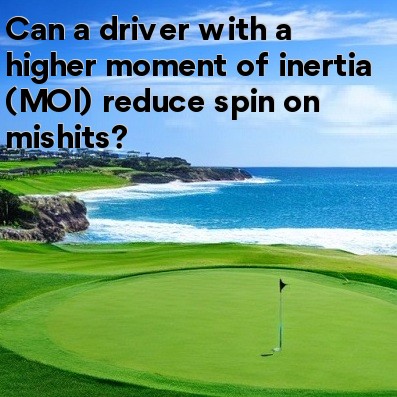
In golf, Can a driver with a higher moment of inertia (MOI) reduce spin on mishits?
When it comes to golf, technology has played a significant role in improving the performance of golf clubs and helping golfers hit better shots. One of the aspects that has been extensively researched and developed is the moment of inertia (MOI) of golf clubs, particularly drivers. The moment of inertia refers to a club's resistance to twisting when it makes contact with the ball. In simple terms, it is a measure of how forgiving a club is on off-center hits.
Traditionally, drivers with a higher MOI have been designed to reduce the negative effects of mishits, such as loss of distance and increased side spin. This is because clubs with higher MOI are more stable and less likely to twist when the ball is struck away from the center of the clubface. The technology behind high-MOI drivers aims to minimize the loss of ball speed and accuracy on mishits, allowing golfers to achieve better results and greater consistency.
Spin is an important factor in golf as it influences the trajectory, distance, and control of the ball. In the case of drivers, reducing spin on mishits is desired because it helps players achieve greater distance and accuracy. With a high-MOI driver, the clubhead is more resistant to twisting, which means that even if the ball is struck off-center, the clubface can maintain its intended angle of attack, reducing the chances of imparting excessive spin to the ball.
The lower spin from a high-MOI driver can be beneficial in a couple of ways. Firstly, it helps reduce the amount of side-spin that is generated on mis-hits. Side-spin leads to slices and hooks, which are shots that curve excessively to the right or left, respectively. By reducing side-spin, a high-MOI driver can promote straighter shots even when the ball is struck away from the center of the clubface.
Secondly, a high-MOI driver can help reduce backspin, which is the spin that makes the ball climb higher in the air and ultimately limits the distance a shot can travel. With less backspin, the ball can maintain a more penetrating and efficient trajectory, maximizing carry and roll distance.
It is important to note that while a high-MOI driver can help reduce spin on mishits, it does not eliminate it completely. Poor contact on the clubface will still result in higher spin compared to a solid, centered strike. However, the overall reduction in spin from a high-MOI driver can significantly improve the results and consistency for golfers, especially those who struggle with hitting the ball on the sweet spot consistently.
In conclusion, a driver with a higher moment of inertia (MOI) can indeed reduce spin on mishits. By increasing the clubhead's resistance to twisting, a high-MOI driver helps maintain the intended angle of attack and minimizes the negative effects of off-center contact. This reduction in spin can lead to straighter shots and greater distance. Golfers looking for more forgiveness and consistency in their drives should consider using a high-MOI driver.





